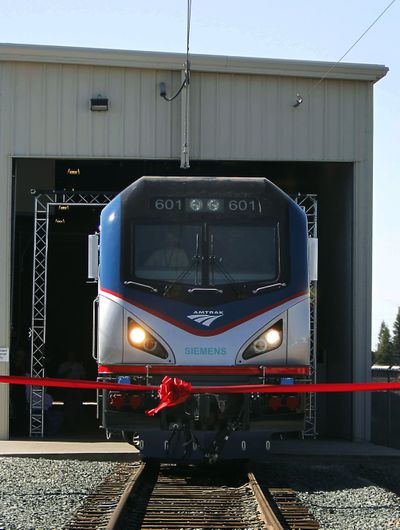Amtrak’s new engines coming down the tracks
Locomotives are more reliable, efficient and easier to maintain

NEWARK, N.J. – Amtrak unveiled the first of 70 new locomotives Monday at a plant in California, in an event the national passenger railroad service hopes will mark a new era of better reliability, streamlined maintenance and increased energy efficiency.
On a broader scale, the new engines could well be viewed as emblematic of the improving financial health of Amtrak, which has long been dependent on subsidies from an often-reluctant Congress.
More than 31 million passengers rode Amtrak in the 2012 fiscal year, generating a record $2.02 billion in ticket revenue. Amtrak says it will be able to pay back a $466 million federal loan for the locomotives over 25 years using net profits from the Northeast Corridor line, where ridership hit a record high last year for the ninth time in 10 years.
“This is not the same organization it was a few years ago, still hoping and relying on federal handouts, limping from appropriation to appropriation,” said Robert Puentes, a senior fellow in the Brooking Institution’s metropolitan policy program. “Even though Washington is mired in debt and dysfunction, Amtrak is reinventing itself.”
The new engines will be used on the Northeast Corridor between Washington, D.C., and Boston and on Keystone Corridor trains that run between Philadelphia and Harrisburg, Pa. Three will be unveiled Monday before being sent out for testing. The first is due to go into service by this fall, and all 70 are expected to be in service by 2016.
Amtrak awarded the contract in 2010 to Munich-based Siemens AG, which has made a big investment in the American rail industry over the last decade. The company makes about one of every three light rail vehicles in North America and is building light rail vehicles for Minneapolis, Houston and San Diego at the Sacramento plant where Amtrak’s locomotives are being produced.
Among the improvements in the new locomotives are computers that can diagnose problems in real time and take corrective action and a braking system capable of generating 100 percent of the energy it uses back to the electric grid – similar to the way a hybrid automobile’s motor acts as a generator when braking, according to Michael Cahill, CEO for Siemens Rail Systems. That could produce energy savings of up to $300 million over 20 years, the company estimates.
They also feature crumple zones, which are basically cages built onto the front end of the train that can absorb impact from a collision. The new models will be the first in North America to use them, in compliance with new federal safety guidelines, Cahill said.
The locomotives, called Amtrak Cities Sprinters, are based on Siemens’ latest European electric locomotive and will replace Amtrak equipment that has been in service for 20 to 30 years and has logged an average of 3.5 million miles.
Simply having the same type of locomotive in operation should cut costs, according to Amtrak spokesman Steve Kulm. Amtrak now uses three locomotive models, requiring slightly different maintenance, parts and training.
“Now, we will have one model, one inventory and one training program, and all that will help efficiency,” Kulm said.
About 750 people are employed at Siemens’ Sacramento plant. The locomotive project also involves Siemens plants in Columbus, Ohio; Richland, Miss.; and Alpharetta, Ga.
The ripple effect spreads farther. As a condition of the Department of Transportation loan, the majority of the products and materials used to build the locomotives must be made in the U.S. As a result, some lighting parts are coming from Connecticut, the driver’s seat from Wisconsin, insulation from Indiana, electronics from Texas and hydraulic parts from California. In all, 70 suppliers in 23 states are providing components, Siemens said.